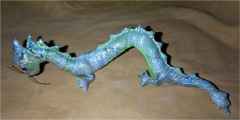|
Midsummer was a time to realign the lunar and solar
calendars. Consequently, it is a festival of both fire and water.
The Dragon which symbolized chaos that life comes from and returns
to, is a fire and water creature. There is also reason to understand
the Dragon as a metaphor for a year. For Celts, the New Year began
when the old dragon was killed, and the new dragon emerged. Although
different cultures mark the New Year at different times, the dragon
metaphor can often still be identified.

Stone age people apparently had counted off the
year based on the earth's movement through the galaxy. Although
time is easy to follow by watching the moon, keeping track of a
solar year would have required the same logic and powers of observation
that modern scientists use. Proof that those ancient tribes had
this information exists in the form of a Paleolithic hercules figure.
Hercules occurs throughout Europe, Northern Africa
and Asia under many different names, but some characteristics are
constant. He wears an animal pelt and carries a staff, club or wand
made of oak. He was a rainmaker and fertilizing force. The oak tree
was sacred to him because it attracted the lightning bolts of storms.
Most of all, he was the sacred hero, the human incarnation of the
sun. Midsummer is his day.
Ancient people, watching the sky for a year would
notice that although the moon is unpredictable, the constellations
are a dependable indication of the time of the solar year. The year
was divided into quarters based on the solstices and equinoxes,
then each quarter was divided into three periods whose length approximated
the length of a lunar cycle. The year and its twelve zodiac constellations
are personified by the hercules and his twelve companions.
But the moon was unruly. After all the careful
observation and painstaking calculation, the single most significant
time marker wouldn't match up with the fixed stars. While some ancient
people may have gathered around the midsummer fire to ponder this
enigma, others who were more literal minded and fastidious invented
religion. Their reasoning was impeccable. Gods require human sacrifice.
Whether flayed, hung, burned alive, torn limb from limb, impaled
or beheaded, the victim's death mollified supernatural powers.
In historic time, that is from about
5000 BCE, we know that it was the solar hero's duty to overpower
the moon. In Shakespeare's Midsummer's Night Dream, this meant Theseus
had to marry the Amazon Queen. One of Greek Hercules twelve labors
was to steal Hippolyta's girdle. The Amazon Queen's girdle would
refer to the Zodiac which the hercules ruled. Another of these famous
labors was to steal the moon goddess's sacred hind with the golden
horns. When the sun god bested the moon goddess the course of time
is brought under control.
Although details of Midsummer rituals vary throughout
Europe, certain themes echo throughout the sun-worshipping lands.
Summer solstice was a time of cleansing by fire and water, a time
when enchantments of love and wealth were most potent, and a time
when earth and nature spirits crossed over into the human realm.
Golden treasures could be found by noting the location of magical
flames that appeared on Midsummer eve. Young girls sought the identity
of their future mates through a variety of magic spells. Fairies,
and witches, walked the paths. Celebrants jumped over fires, or
walked through fires in hopes of benefiting from the cleansing flames,
and possibly in hopes of gaining some of the sun's power through
association. Bonfires, fires fed with bones and bad smelling refuse,
were ignited in hopes of driving off dragons who would otherwise
contaminate wells and water sources. Torches were carried through
fields to drive disease from crops, while cattle were led through
fires to cleanse them of vampire-like creatures that may have taken
residence between their horns. Sometimes a burning wheel that was
meant to represent the sun, was rolled down a hill. Fires were burnt
at crossroads and beside lakes.
While primarily a fire festival acknowledging the
sun's turning, water magic is particularly potent at this time also.
Bathing in some pools had curative and restorative effects. In some
places, washing in dew collected on Midsummer eve was magical, while
in other places, bathing in water steeped with herbs over Midsummer
night could cure and restore health and vigor.
Because the forces of nature get out of control
during this magical time of year, boundaries between natural and
supernatural broke down. Shakespear caught the disorienting unruliness
in A Midsummer's Night Dream. Puck usually used the night
to play tricks on rustics, but when he had the magic pansy in his
hands, he used it to help a distraught lover. Of course, for all
his good intentions, the plan went awry, which is always likely
to happen at this unruly time of year.
This is also a good time to search for treasure
that otherwise is hidden in the earth. Ferns or flames sometimes
show treasure hunters where to look, but often restraints of strict
silence have to be observed. So many people on the verge of becoming
rich with gold, spoke or gasped, and broke the spell. Silence was
also important to many of the love-charms and fortune telling that
took place on Midsummer's eve.
Farther south, in the arid lands that appreciated
the watery moon rather than the hot sun, human sacrifice was practiced
at summer solstice to appease the fearsome sun god. When the sun
was at its zenith, the crops withered, pools evaporated, and ancient
people mourned the death of Adonis, or Tammuz, the corn god. First-born
children were fed to the sun god to turn his wrath. Even into modern
times, animal sacrifice, as instituted by Abraham in Genesis, is
practiced at this festival. Pilgrims drink at the fountain of Haggar,
and first-born children thank their god that it is animals that
are sacrificed.
The dragon's part in ancient rituals are significant.
Although it is possibly just a metaphor of the year, swallowing
the sun and giving it birth alternately, it was also thought of
as a contaminating force of nature, polluting the waters and withering
crops. Effigies of the old dragon, or death, are burned in modern
bonfires.
Christians were not very successful in the attempt
to claim this festival by fixing June 24th as the birthday
of John the Baptist. Midsummer, being opposite on the Wheel of life
from winter solstice, put St. John opposite Jesus, the Adonis of
Christians. Already portrayed in Christian myth as twins, these
two solstice heroes accurately illustrate Robert Graves' theory
of dying gods. Jesus and John as twins, illustrated in early Christian
art, were both blood sacrifices ruling opposite solstices. One mortal,
one immortal, they depict the connection of modern religion with
the ancient pagan rites. That St. John wears the animal pelt and
carries an oak staff illustrates that he is just one of many hercules
figures. In spite of Church restraints, this remains a festival
of Zodiac heroes and magic.
Magic is unleashed when Nature, sometimes personified
as Salome, lifts her veil in Midsummer. Some of this magic can be
harvested in herbs, flowers and fern seed . Mistletoe cut on Midsummer
eve will cure all. Ashes from oak fires are magic aids to health
and protection from storms and fire.
This is the fairies merriest day. They might be
willing to do you a favor, but they also like to play pranks now
that they're loose. Put thistles around your barn so pookas don't
steal the milk. Dance around the fire by the water with your sweetheart
or carry a torch in a boat on the lake. This is the most magical
time of the year, so remember to wear a sprig of thyme in your hair.
|

